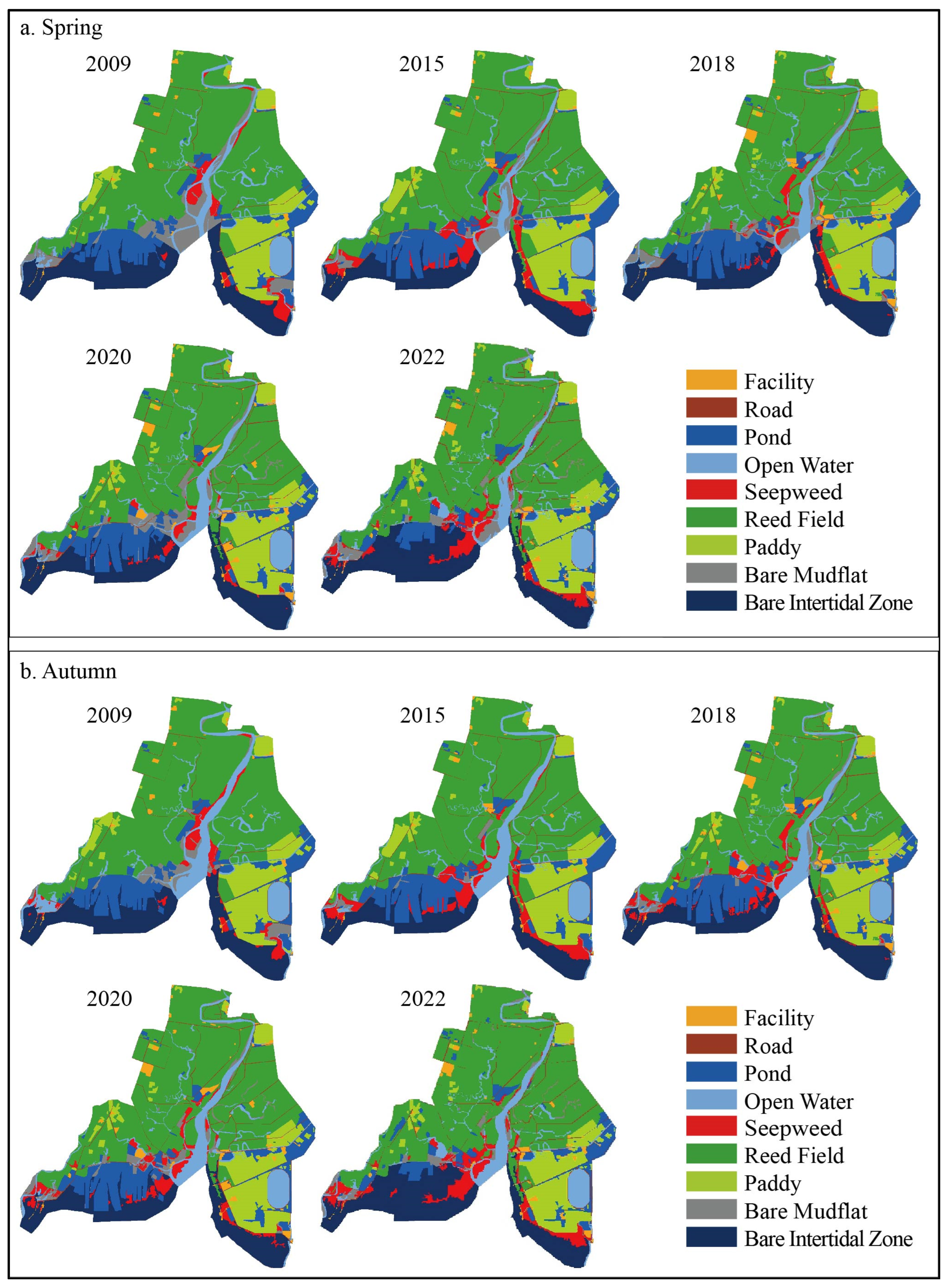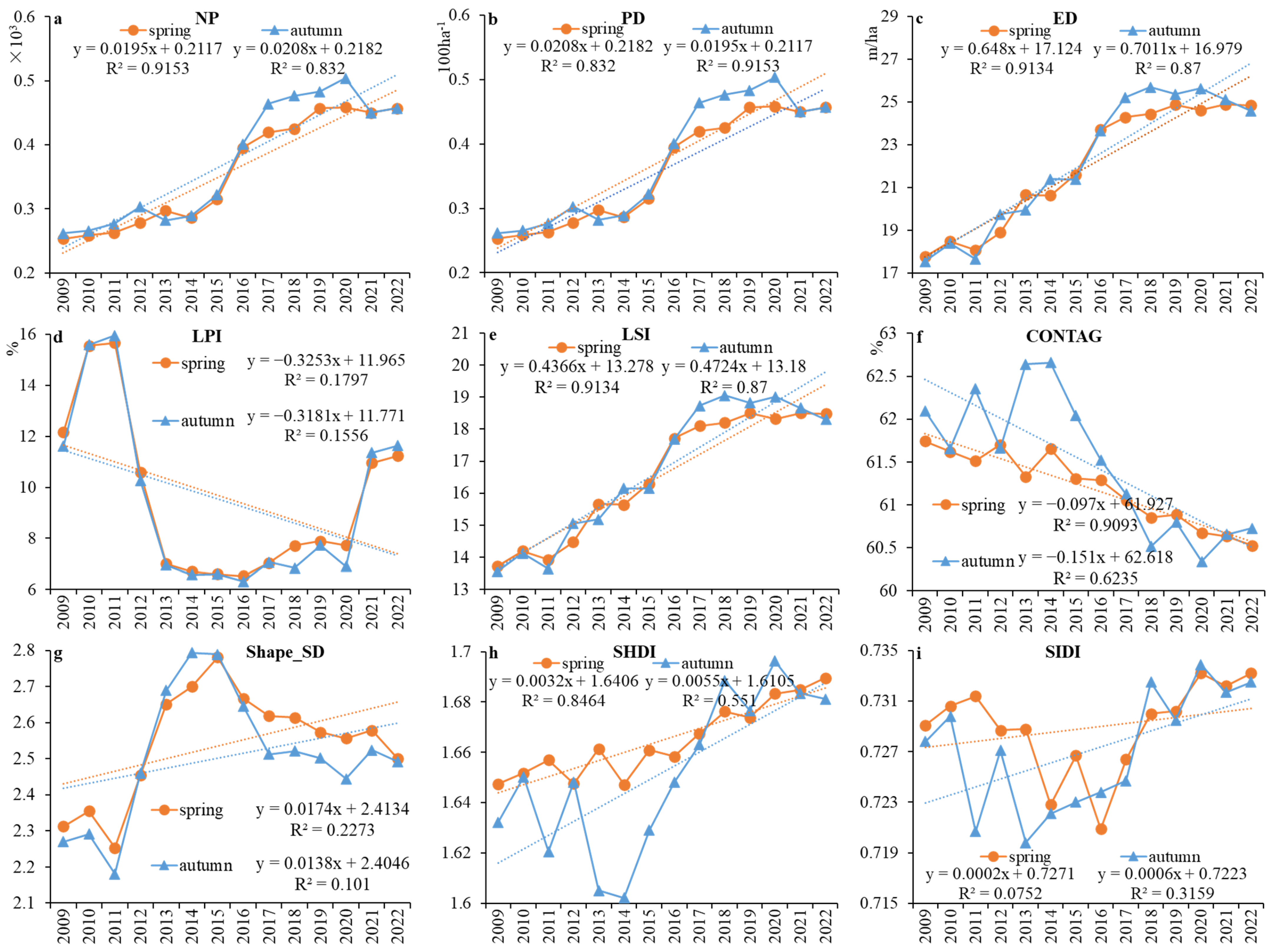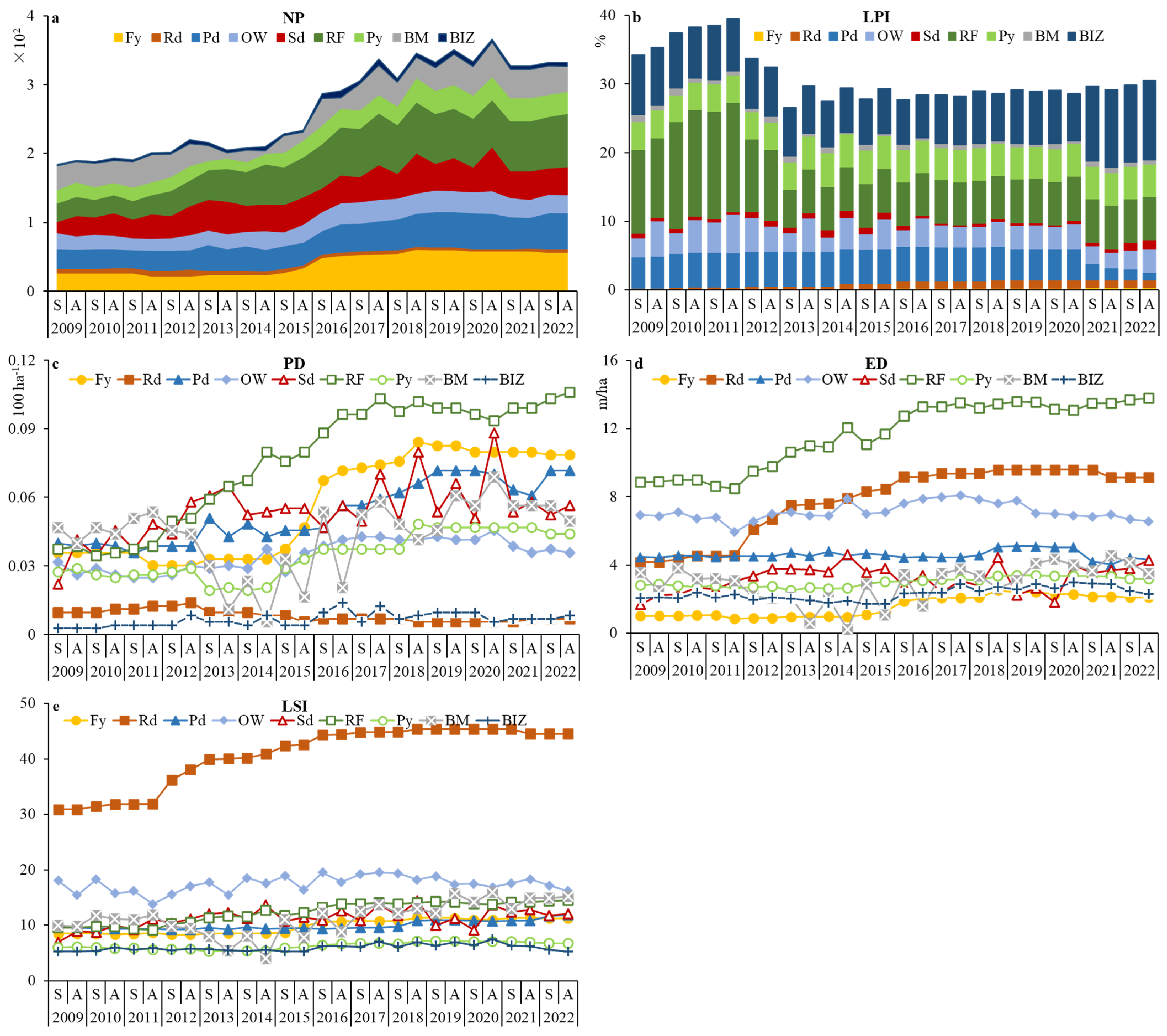Assessing the Effectiveness of Large-Scale Ecological Restoration Measures in the Liaohe Estuary Using a Landscape Pattern Perspective
Abstract
1. Introduction
2. Materials and Methods
2.1. Study Area
2.2. Remote-Sensing Image Acquisition and Pretreatment
2.3. Different Types of Land Use Classification
2.4. Statistical Analysis
2.4.1. Spatiotemporal Changes in the Landscape
2.4.2. Landscape Fragmentation Changes
2.4.3. Flows between the Different Landscape Patterns
3. Results
3.1. Spatiotemporal Changes in Landscape Patterns
3.2. Changes in the Landscape Fragmentation
3.3. Transitions between the Landscape Types
4. Discussion
4.1. Driving Factors of Landscape Pattern Change in the Different Stages
4.2. Reasons for the Landscape Fragmentation Changes
4.3. Effects of the Conservation Measures and Policies on Coastal Wetlands
5. Conclusions
Author Contributions
Funding
Institutional Review Board Statement
Informed Consent Statement
Data Availability Statement
Acknowledgments
Conflicts of Interest
References
- Costanza, R.; D’Arge, R.; Groot, R.D.; Farber, S.; Grasso, M.; Hannon, B.; Limburg, K.; Naeem, S.; O’Neill, R.V.; Paruelo, J.; et al. The value of the world’s ecosystem services and natural capital. Nature 1997, 387, 253–260. [Google Scholar] [CrossRef]
- Mitsch, W.J.; Jiang, B.B.; Miller, S.K.; Boutin, K.D.; Zhang, L.; Wilson, A.; Bakshi, B.R. Wetlaculture: Solving Harmful Algal Blooms with a Sustainable Wetland/Agricultural Landscape. In Engineering and Ecosystem; Bakshi, R.B., Ed.; Springer: Cham, Switzerland, 2023; pp. 333–354. [Google Scholar]
- Barbier, E.B.; Hacker, S.D.; Kennedy, C.; Koch, E.W.; Stier, A.C.; Silliman, B.R. The value of estuaries and coastal ecosystem services. Ecol. Monogr. 2011, 81, 169–193. [Google Scholar] [CrossRef]
- Barbier, E.B. Valuing ecosystem services for coastal wetland protection and restoration: Progress and challenges. Resources 2013, 2, 213–230. [Google Scholar] [CrossRef]
- Day, J.W.; Crump, B.C.; Kemp, W.M.; Arancibia, A.Y. Estuarine Ecology, 3rd ed.; John Wiley & Sons Inc.: Hoboken, NJ, USA, 2013; pp. 537–550. [Google Scholar]
- Newton, A.; Carruthers, T.J.B.; Icely, J. The coastal syndromes and hotspots on the coast. Estuar. Coast. Shelf Sci. 2012, 96, 39–47. [Google Scholar] [CrossRef]
- Halpern, B.S.; Walbridge, S.; Selkoe, K.A.; Kappel, C.V.; Micheli, F.; D’Agrosa, C.; Bruno, J.F.; Casey, K.S.; Ebert, C.; Fox, H.E.; et al. A global map of human impact on marine ecosystems. Science 2008, 319, 948–952. [Google Scholar] [CrossRef]
- Lotze, H.K.; Bruce, H.S.L.; Lenihan, H.S.; Bourque, B.J.; Bradbury, R.H.; Cooke, R.G.; Kay, M.C.; Kidwell, S.M.; Kirby, M.X.; Peterson, C.H.; et al. Depletion, degradation, and recovery potential of estuaries and coastal seas. Science 2006, 312, 1806–1809. [Google Scholar] [CrossRef]
- Worm, B.; Barbier, E.B.; Beaumont, N.; Duffy, J.E.; Folke, C.; Halpern, B.S.; Jackson, J.B.C.; Lotze, H.K.; Micheli, F.; Palumbi, S.R.; et al. Impacts of biodiversity loss on ocean ecosystem services. Science 2006, 314, 787–790. [Google Scholar] [CrossRef]
- Kim, S.G. The evolution of coastal wetland policy in developed countries and Korea. Ocean Coast Manag. 2010, 53, 562–569. [Google Scholar] [CrossRef]
- Cao, W.Z.; Wong, M.H. Current status of coastal zone issues and management in China: A review. Environ. Int. 2007, 33, 985–992. [Google Scholar] [CrossRef] [PubMed]
- Wang, Y. Coastal management in China. In Ocean Management in Global Change; Fabbri, P., Ed.; Elsevier Applied Science: London, UK, 1992; pp. 471–488. [Google Scholar]
- Sun, W.L. Evaluation on Spatial-Temporal Pattern of Carbon Emission and Carbon Budget in Tidal Marsh Ecosystem of the Yellow River Delta. Master’s Thesis, University of the Chinese Academy of Sciences (Yantai Institute of Coastal Zone Research), Beijing, China, 2014. [Google Scholar]
- Sun, Z.G.; Sun, W.G.; Tong, C.; Zeng, C.S.; Yu, X.; Mou, X.J. China’s coastal wetlands: Conservation history, implementation efforts, existing issues and strategies for future improvement. Environ. Int. 2015, 79, 25–41. [Google Scholar] [CrossRef] [PubMed]
- Ma, Z.J.; Choi, C.Y.; Gan, X.J.; Li, J.; Liu, Y.; Melville, D.S.; Mu, T.; Piersma, T.; Zhang, Z.W. Achievements, challenges, and recommendations for waterbird conservation in China’s coastal wetlands. Avian Res. 2023, 14, 100123. [Google Scholar] [CrossRef]
- The Xinhua News Agency. China Will Conduct the “Blue Bay” and Other Projects to Restore the Ocean’s Ecological Environment. 2016. Available online: https://www.gov.cn/xinwen/2016-01/22/content_5035381.htm (accessed on 1 September 2023).
- Sun, J.W.; Fang, H.C.; Yu, Y.H.; Wang, P.; Ying, J.; Dong, X.K.; Tang, C. Comprehensive treatment of coastal area in China based on the construction of marine ecological civilization. Mar. Dev. Manag. 2019, 36, 29–32. [Google Scholar]
- O’Neill, R.V.; Hunsaker, C.T.; Jones, K.B.; Riitters, K.H.; Wickham, J.D.; Schwartz, P.M.; Goodman, I.A.; Jackson, B.L.; Baillargeon, W.S. Monitoring environmental quality at the landscape scale. Bioscience 1997, 47, 513–519. [Google Scholar] [CrossRef]
- O’Neill, R.V.; Riitters, K.H.; Wickham, J.D.; Jones, K.B. Landscape pattern metrics and regional assessment. Ecosyst. Health 1999, 5, 225–233. [Google Scholar] [CrossRef]
- Zhu, C.M.; Zhang, X.L.; Zhou, M.M.; He, S.; Gan, M.Y.; Yang, L.X.; Wang, K. Impacts of urbanization and landscape pattern on habitat quality using OLS and GWR models in Hangzhou, China. Ecol. Indic. 2020, 117, 106654. [Google Scholar] [CrossRef]
- Sun, X.C. Liaoning Blue Bay Renovation Action Project Was Approved 300 Million RMB by the Central Government Investment. 2016. Available online: https://www.sohu.com/a/110148119_114984 (accessed on 1 September 2023).
- Du, J.; Song, K.S. Validation of global evapotranspiration product (mod16) using flux tower data from Panjin coastal wetland, northeast China. Chin. Geogr. Sci. 2018, 28, 420–429. [Google Scholar] [CrossRef]
- Li, H.F.; Li, L.F.; Su, F.L.; Wang, T.L.; Gao, P. The periodic response of tidal flat sediments to runoff variation of upstream main river: A case study in the Liaohe estuary wetland, China. Water 2020, 12, 61. [Google Scholar] [CrossRef]
- Wang, C.; Wang, G.; Dai, L.J.; Liu, H.Y.; Li, Y.F.; Zhou, Y.; Chen, H.; Dong, B.; Lv, S.C.; Zhao, Y.Q. Diverse usage of waterbird habitats and spatial management in Yancheng coastal wetlands. Ecol. Indic. 2020, 117, 106583. [Google Scholar] [CrossRef]
- Ge, M.; Wu, F.P.; Chen, X.P. A coupled allocation for regional initial water rights in Dalinghe basin, China. Sustainability 2017, 9, 428. [Google Scholar] [CrossRef]
- Ke, X.; Gui, S.F.; Huang, H.; Zhang, H.J.; Wang, C.Y.; Guo, W. Ecological risk assessment and source identification for heavy metals in surface sediment from the Liaohe River protected area, China. Chemosphere 2017, 175, 473–481. [Google Scholar] [CrossRef]
- Brix, H.; Ye, S.Y.; Laws, E.A.; Sun, D.C.; Li, G.S.; Ding, X.G.; Yuan, H.M.; Zhao, G.M.; Wang, J.; Pei, S.F. Large-scale management of common reed, Phragmites australis, for paper production: A case study from the Liaohe Delta, China. Ecol. Eng. 2014, 73, 760–769. [Google Scholar] [CrossRef]
- Ji, Y.H.; Zhou, G.S.; New, T. Abiotic factors influencing the distribution of vegetation in coastal estuary of the Liaohe Delta, Northeast China. Estuaries Coast 2009, 32, 937–942. [Google Scholar] [CrossRef]
- Sun, J.; Yang, D.M.; Li, J.G. Study on spatio-temporal change and forecast of land use in Liaohe river delta. J. Huazhong Agric. Univ. Soc. Sci. Ed. 2006, 1, 28–32. [Google Scholar]
- Zhang, Y.N.; Liu, B.Y.; Dong, L.; Jiang, H.X.; Wang, X.; Wang, X.M.; Song, C.Z.; Li, X.M.; Li, S.H. High genetic diversity and absence of phylogeographic structure in breeding populations of vulnerable Saundersilarus saundersi (Charadriiformes: Laridae) in Bohai Bay, China. Conserv. Genet. 2017, 18, 495–500. [Google Scholar] [CrossRef]
- Guo, C.L.; Dai, Y.J.; Cui, J.; Sun, X.B.; Ma, Y.X.; Ai, C.F. Wide forest abundant grass, colorful water and beautiful mountain—The revitalization of the Daling River estuary wetland. Sci. Pop. Cult. Land Resour. 2020, 02, 34–37. [Google Scholar]
- Yan, X.L.; Hu, Y.M.; Chang, Y.; Zhang, D.H.; Liu, M.; Guo, J.T.; Ren, B.H. Monitoring wetland changes both outside and inside reclamation areas for coastal management of the northern Liaodong Bay, China. Wetlands 2017, 37, 885–897. [Google Scholar] [CrossRef]
- Zhang, W. The CPC Central Committee’s Proposal on the Formulation of the Thirteenth Five-Years Plan Released—The Ocean as a New Space for Exploration and Development. 2015. Available online: https://www.gov.cn/xinwen/2015-11/05/content_5005020.htm (accessed on 2 September 2023).
- Ministry of Ecology and Environment. The Ministry of Ecology and Environment Interviewed Eight Municipal (Prefecture, District) Governments and Relevant Departments on the Problem of Encroachment and Destruction of Nature Reserves. 2018. Available online: https://www.mee.gov.cn/xxgk2018/xxgk/xxgk15/201809/t20180926_661929_wh.html (accessed on 28 November 2023).
- Hu, H.L. The Ecological Restoration Project of Bohai Bay in Liaoning Comprehensive Treatment Has Been Accepted. 2021. Available online: https://www.sohu.com/a/480549018_726570 (accessed on 28 November 2023).
- Li, J.Y.; Tang, L. Panjin: Retire Aquaculture Still Wetlands Guard Blue Bay. 2020. Available online: http://ln.people.com.cn/n2/2020/0928/c378489-34324364.html (accessed on 28 November 2023).
- Zheng, Y.P. Research on Landsat-7 SLC-Off Bad Track Repair Method Based on Image Classification Assisted by HJ-1A/1B. Master’s Thesis, Huazhong Normal University, Wuhan, China, 2016. [Google Scholar]
- Kawata, Y.; Ueno, S.; Kusaka, T. Radiometric correction for atmospheric and topographic effects on Landsat MSS images. Int. J. Remote Sens. 1988, 9, 729–748. [Google Scholar] [CrossRef]
- Svatonova, H. Analysis of visual interpretation of satellite data. Int. Arch. Photogramm. Remote Sens. Spat. Inf. Sci. 2016, XLI-B2, 675–681. [Google Scholar]
- Mcgarigal, K.; Cushman, S.A.; Ene, E. Fragstats v4: Spatial Pattern Analysis Program for Categorical and Continuous Maps; Computer Software Program Produced by the Authors at the University of Massachusetts: Amherst, MA, USA, 2012; Available online: https://www.scirp.org/reference/referencespapers?referenceid=1892846 (accessed on 10 November 2023).
- Mccune, B.; Mefford, M.J. Pc-ord: Multivariate Analysis of Ecological Data, Version 7.0 for Windows; Wild Blueberry Media: Corvallis, OR, USA, 2016; Available online: https://www.wildblueberrymedia.net/pcord-booklet (accessed on 10 November 2023).
- Cuba, N. Research note: Sankey diagrams for visualizing land cover dynamics. Landsc. Urban Plan 2015, 139, 163–167. [Google Scholar] [CrossRef]
- Schmidt, M. The Sankey diagram in energy and material flow management. J. Ind. Ecol. 2008, 12, 82–94. [Google Scholar] [CrossRef]
- Wang, J.; Liu, X.Y.; Zhang, X.Y.; Liang, X.; Zhang, W.J. Growth response and phytoremediation ability of reed for diesel contaminant. Procedia Environ. Sci. 2011, 8, 68–74. [Google Scholar] [CrossRef]
- Wang, G.D.; Wang, M.; Lu, X.G.; Jiang, M. Surface elevation change and susceptibility of coastal wetlands to sea level rise in Liaohe Delta, China. Estuar. Coast. Shelf Sci. 2016, 180, 204–211. [Google Scholar] [CrossRef]
- Qiao, H.T.; Zhang, M.L.; Jiang, H.Z.; Xu, T.P.; Zhang, H.X. Numerical study of hydrodynamic and salinity transport processes in the pink beach wetlands of the Liao River estuary, China. Ocean Sci. 2018, 14, 437–451. [Google Scholar] [CrossRef]
- Ling, H.Y. Study on the Development Strategy of Liaohe Estuary Paper Products Industrial Park. Master’s Thesis, Guangxi University, Guangxi, China, 2018. [Google Scholar]
- Yi County People’s Government. The Daling River Bridge of Fujin Section in Yi County Was Officially Opened to Traffic. 2016. Available online: http://www.lnyx.gov.cn/info/1038/6823.htm (accessed on 28 November 2023).
- Xu, Q.; Wang, X.L.; Xiao, B.; Hu, K.L. Rice-crab coculture to sustain cleaner food production in Liaohe River Basin, China: An economic and environmental assessment. J. Clean. Prod. 2019, 208, 188–198. [Google Scholar] [CrossRef]
- Xie, P.C. Study on Countermeasures of Ecotourism Development for Red Beach in Panjin. Master’s Thesis, Beihua University, Jilin, China, 2021. [Google Scholar]
- People’s Information. Panjin: “Returning Aquaculture to Wetland” Guard the Blue Bay. 2020. Available online: https://baijiahao.baidu.com/s?id=1679271906263227127&wfr=spider&for=pc (accessed on 28 November 2023).
- Panjing Ecology and Environment Bureau. The Provincial Government Inspection Office Checked the Rectification for Natural Conservation. 2018. Available online: https://sthjj.panjin.gov.cn/2018_10/19_09/content-223898.html (accessed on 28 November 2023).
- Li, X.Z.; Anderson, C.J.; Wang, Y.Y.; Lei, G.C. Waterbird diversity and abundance in response to variations in climate in the Liaohe Estuary, China. Ecol. Indic. 2021, 132, 108286. [Google Scholar] [CrossRef]
- Song, J.; Fan, H.; Zhao, Y.Y.; Jia, Y.H.; Du, X.H.; Wang, B.S. Effect of salinity on germination, seedling emergence, seedling growth and ion accumulation of a euhalophyte Suaeda salsa in an intertidal zone and on saline inland. Aquat. Bot. 2008, 88, 331–337. [Google Scholar] [CrossRef]
- Zhou, S.W.; Wang, C.; Li, Y.F.; Huang, W.C.; Jia, Y.; Wang, Y.Q.; Xu, W.; Qiu, C.Q.; Liu, H.Y. Study on spatio-temporal variation and hydrological connectivity of tidal creek evolution in Yancheng coastal wetlands. Environ. Sci. Pollut. Res. Int. 2023, 30, 37143–37156. [Google Scholar] [CrossRef] [PubMed]
- Luo, M.; Wang, Q.; Qiu, D.D.; Shi, W.; Ning, Z.H.; Cai, Y.Z.; Song, Z.F.; Cui, B.S. Characteristics of hydrological connectivity and its ecological effects in a typical tidal channel system of the Yellow River Delta. J. Beijing Norm. Univ. Nat. Sci. 2018, 54, 17–24. [Google Scholar]
- Borja, Á.; Dauer, D.M.; Elliott, M.; Simentstad, C. Medium- and Long-term Recovery of Estuarine and Coastal Ecosystems: Patterns, Rates and Restoration Effectiveness. Estuar. Coasts 2010, 33, 1249–1260. [Google Scholar] [CrossRef]
- Yu, Z.B.; Huang, L.B.; Bai, J.H.; Zhang, G.L.; Wang, W.; Wang, D.W.; Wang, C.; Wang, Y.Q.; Chen, G.Z.; Liu, Z. Seasonal response of Suaeda salsa to hydrological connectivity in intertidal salt marshes through changing trait networks. Catena 2023, 222, 106857. [Google Scholar] [CrossRef]
- Han, N.; Shao, Q.; Lu, C.M.; Wang, B.S. The leaf tonoplast V-H+-ATPase activity of a C3 halophyte Suaeda salsa is enhanced by salt stress in a Ca-dependent mode. J. Plant Physiol. 2005, 162, 267–274. [Google Scholar] [CrossRef]
- Jiang, S.; Xu, N.; Li, Z.C.; Huang, C.H. Satellite derived coastal reclamation expansion in China since the 21st century. Glob. Ecol. Conserv. 2021, 30, e01797. [Google Scholar] [CrossRef]
- Jia, Y.G.; Zheng, J.W.; Yue, Z.Q.; Liu, X.L.; Shan, H.X. Tidal flat erosion of the Huanghe River Delta due to local changes in hydrodynamic conditions. Acta Oceanol. Sin. 2014, 33, 116–124. [Google Scholar] [CrossRef]
- Zheng, G.H.; Wang, Y.; Zhao, C.Y.; Dai, W.; Kattel, G.R.; Zhou, D. Quantitative analysis of tidal creek evolution and vegetation variation in silting muddy flats on the Yellow Sea. Remote Sens. 2023, 15, 5107. [Google Scholar] [CrossRef]
- Duarte, C.M.; Borja, A.; Carstensen, J.; Elliott, M.; Krause-Jensen, D.; Marbà, N. Paradigms in the Recovery of Estuarine and Coastal Ecosystems. Estuaries Coasts 2013, 38, 1202–1212. [Google Scholar] [CrossRef]






| Landscape Types | Sample Image | Description |
|---|---|---|
| Facility (Fy) |  | Taupe connection with punctiform, linear, and punctiform |
| Road (Rd) |  | Grey and connected zone images |
| Pond (Pd) |  | Continuous ponds with regular shapes |
| Open water (OP) |  | Wide freshwater surface with curved shape, and reservoir |
| Seepweed (Sd) |  | Scattered red patches between reed fields and intertidal zones |
| Reed field (RF) |  | Large green patches with irregular shapes |
| Paddy (Py) |  | Green–yellow and serried rectangle with regular shapes |
| Bare mudflat (BM) |  | Bare mudbank without any vegetation cover around freshwater area |
| Bare intertidal zone (BIM) |  | Intertidal flat without any vegetation cover |
Disclaimer/Publisher’s Note: The statements, opinions and data contained in all publications are solely those of the individual author(s) and contributor(s) and not of MDPI and/or the editor(s). MDPI and/or the editor(s) disclaim responsibility for any injury to people or property resulting from any ideas, methods, instructions or products referred to in the content. |
© 2024 by the authors. Licensee MDPI, Basel, Switzerland. This article is an open access article distributed under the terms and conditions of the Creative Commons Attribution (CC BY) license (https://creativecommons.org/licenses/by/4.0/).
Share and Cite
Li, X.; Ji, B.; Li, N.; Chen, Q.; Anderson, C.J.; Wang, Y. Assessing the Effectiveness of Large-Scale Ecological Restoration Measures in the Liaohe Estuary Using a Landscape Pattern Perspective. Sustainability 2024, 16, 7151. https://doi.org/10.3390/su16167151
Li X, Ji B, Li N, Chen Q, Anderson CJ, Wang Y. Assessing the Effectiveness of Large-Scale Ecological Restoration Measures in the Liaohe Estuary Using a Landscape Pattern Perspective. Sustainability. 2024; 16(16):7151. https://doi.org/10.3390/su16167151
Chicago/Turabian StyleLi, Xiuzhong, Baocun Ji, Na Li, Qiuying Chen, Christopher J. Anderson, and Yuexuan Wang. 2024. "Assessing the Effectiveness of Large-Scale Ecological Restoration Measures in the Liaohe Estuary Using a Landscape Pattern Perspective" Sustainability 16, no. 16: 7151. https://doi.org/10.3390/su16167151
APA StyleLi, X., Ji, B., Li, N., Chen, Q., Anderson, C. J., & Wang, Y. (2024). Assessing the Effectiveness of Large-Scale Ecological Restoration Measures in the Liaohe Estuary Using a Landscape Pattern Perspective. Sustainability, 16(16), 7151. https://doi.org/10.3390/su16167151






